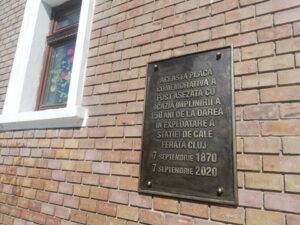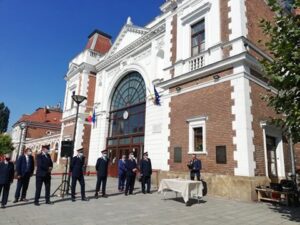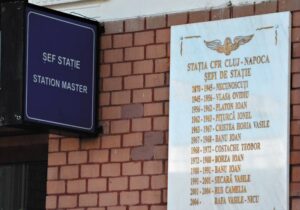This past Monday, a memorial tablet was inaugurated on a wall at Kolozsvár’s (Cluj-Napoca) main railway station in commemoration of the 150th anniversary of the construction of the Nagyvárad (Oradea) – Kolozsvár railroad. “The autumn of 1870 was of paramount importance, as it brought Budapest and Vienna closer to Kolozsvár,” the regional director said at the ceremony. The only problem is that the plaque does not reflect the multilingualism of the Austro-Hungarian Monarchy, as the inscription on it is only written in Romanian. (kronikaonline.ro)

The memorial tablet was inaugurated on Monday at the Kolozsvár railway station in commemoration of its 150th anniversary. The Kolozsvár stationmaster of the Romanian Railway Company (CFR), Vasile Nicu Rafa, expressed his happiness that during the past 150 years, several millions of passengers have traveled through the town and that the station has provided work for several thousands of people. Following the Romanian national anthem, the Orthodox Metropolitan Archbishop of Kolozsvár, Andrei Andreicuț, blessed the plaque. Regional director Vasile Daniel Rad then emphasized in his speech that
the autumn of 1870 was of paramount importance, as it brought Budapest and Wien closer to Kolozsvár.
Ex-CFR director József Szentes had a similar opinion, saying that the 150th anniversary holds great importance because of Romania successfully being connected to Transylvania over the years — or, Transylvania to Romania.
Representatives of the Hungarian State Railway Company (MÁV) could not be present personally at the ceremony because of the coronavirus pandemic and Hungary’s strict entry requirements, which have been in force since September 1.
So, the message of MÁV director Attila Józsefné Mucsi was read out by Zsolt Bartha, reminding those present that the idea of building the main railroad line of Nagyvárad-Kolozsvár-Segesvár (Sighișoara)-Brassó (Brasov) had already been thought of in 1847. But because of the heavy and long debate between different interest groups as to the exact route, the final decision was made only 20 years later.
The railroad construction was finally ratified by the 1868 XLV. bill, which was then
sanctified by Emperor Franz Joseph on December 6, 1868.
Three months later, on March 8, 1869, the Hungarian Eastern Railway Corporation was founded, and construction on the first section of the railroad between Nagyvárad and Kolozsvár began.
Because of topographical challenges, the 152-kilometer-long Nagyvárad-Kolozsvár section was only inaugurated on September 7, 1870, eight months after the originally planned date of December 31, 1869. “Magyar Keleti Vasút” (Hungarian Eastern Railway) or “M.K.V.” was written on all the carriages and engines. The engines were manufactured in the Sigl engine factory in Wiener Neustadt (Bécsújhely) and received numbers instead of names, as was common back in those days, Bartha said.

He added that two years after the founding of the Hungarian State Railway Company, thanks to the Hungarian Eastern Railway, people could already travel by train between Nagyvárad and Kolozsvár; since then, this section has been an integral part of the area’s train service as well as a main line of Romania’s railroad network.
“We are also proud of this. One hundred and fifty years is a long time. Country borders, forms of states, economic forces have all changed, but the railway service has been stable and, in the future, will be involved even more in public transport. The operation of the Corona InterCity train and, through this, the interconnection of Hungary with Transylvania, are also crucially important for the Hungarian State Railway,” Bartha said at the ceremony.
Not the first case of attempting to erase Romania’s Hungarian past
The plaque inaugurated on Monday is not the first example of only Romanian being used when Hungarian should have clearly been incorporated as well — an overt attempt to erase Kolozsvár’s very Hungarian past. Regional branch office representatives of the Romanian Railway Company (CFR) placed another marble tablet on the wall of the Kolozsvár railway station in May 2014, listing past stationmasters and their time of service.
The only fly in the ointment was that the stationmasters serving between 1870 and 1945 were marked as “unknown” on the tablet, which resulted in great indignation among not only Hungarians but Romanians too. Many accused CFR of conveniently “forgetting” the names of the stationmasters serving during the Austro-Hungarian Monarchy and before the end of WWII in order to erase the Hungarian past of this area of Romania.

One year later, the failure was corrected, and as a result of a Hungarian-Romanian collaboration, the names of the missing Hungarian and German stationmasters were also placed on the plaque. We only hope that the same will happen in the case of the new memorial plate inaugurated on Monday.
Title image: Memorial tablet inauguration on September 7, 2020, on a wall of the Kolozsvár (Cluj-Napoca) main railway station commemorating the 150th anniversary of the building of the Nagyvárad– Kolozsvár railroad. (Photo: Laura Bede)